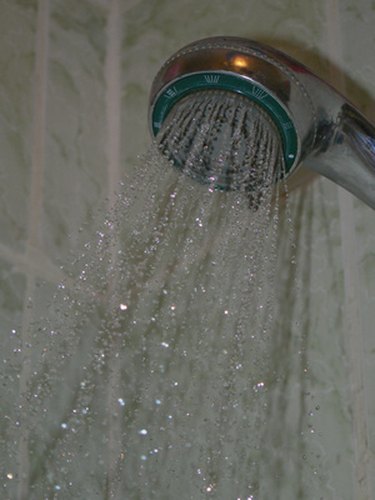Things You'll Need
Shower kit
2-by-4 wall stud
Power saw
Pencil
Drill gun
Metal bracing (roll)
1 5/8-inch galvanized screws
Tubing cutter
Copper pipe
Copper couplings
Emery cloth
Lead-free soldering paste (flux)
Small brush
Lead-free solder
Propane torch
Rag

Shower valves (or mixing valves) come in a package known as a shower kit, and comprise of the mixing valve, hot/cold knobs, brass shower head fixture, shower head arm and also the shower head. The instructions will tell you where to place the mixing valve--how high, and the distance from the side of the shower wall. When installing, make sure that the shower kit does not face the shower door, but is adjacent to the door. If it faces the door, the water from the shower head will hit you when turned on. But if the shower head is adjacent to the door, you can turn the water on and off without being soaked.
Step 1
Install the mixing valve and the brass shower head fixture according to instructions. Each should be attached to their own horizontal piece of 2-by-4 wall stud, and these studs will in turn be screwed between two existing vertical wall studs. The mixing valve is best attached to the stud with metal bracing and 1 5/8-inch galvanized screws, and the brass shower head fixture has holes on each side to screw it directly into the horizontal wall stud.
Video of the Day
Step 2
Locate the existing hot/cold water pipes, and run new copper pipes over to the bottom of the mixing valve--hot usually goes into the left mixing valve inlet. Turn off the water at the main shutoff valve and drain the pipes (open the lowest faucet in the house). Cut into the existing pipes by placing a tubing cutter around one pipe and tightening the blade down onto the pipe. Rotate the pipe once, and tighten and rotate the blade a second time. Repeat until the pipe is cut through. Do the same with the other pipe.
Step 3
Sand the end of both pipes (1 inch) as well as the inside of two straight couplings. Apply lead-free soldering paste (flux) to all sanded areas with a small brush. Push the couplings onto the ends of the two pipes. Continue in the same fashion, cutting new pieces of pipe to the required length and adding couplings where needed, until you finally reach the bottom of the mixing valve (both pipes will be prepared in the same way and inserted into the two valve inlets). Now prepare and install one piece of new pipe from the top of the mixing valve to the bottom of the brass shower head fitting.
Step 4
Unroll 12 inches of solder from its spool, bending the last 2 inches to a 90-degree angle. Turn on the propane torch and starting where the new pipes are attached to the existing pipes. Solder each and every new coupling as follows: Hold the flame against the coupling, moving it from side to side. Do the same at the back of the coupling. When you hear the flux sizzling, take the flame away and touch the end of the solder to the seam between the coupling and copper pipe. If the solder melts, apply 3/4-inch of solder to the seam (capillary action will suck the solder down in between the coupling and pipe). Wipe away all excess solder with a damp rag, but remember that the coupling will be hot. Don't forget to solder all inlets and outlets on the mixing valve/brass shower fitting in the same way.
Tip
The mixing valve has two inlets at the bottom for hot and cold water lines to be attached to. Its top has one central outlet for a water line to go up to an inlet at the bottom of the brass shower head fitting. All inlets and outlets need to be prepared and soldered in place. The brass shower head fitting is usually installed about 6 inches above the top of the shower wall, and equidistant between the hot/cold valve knobs. However, always read the instructions regarding the correct location. Different types of coupling exist to help you install new copper pipe around corners. The come in straight, 30-, 45-, 60- and 90-degree angles. Copper pipe and couplings come in 1/2-inch and 3/4-inch diameters. Though it's much more likely that you'll be using 1/2-inch diameter copper/couplings, check your existing water pipes as well as the shower kit instructions.
Video of the Day